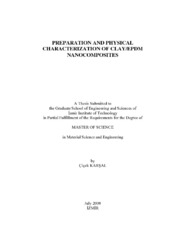Please use this identifier to cite or link to this item:
https://hdl.handle.net/11147/3809Full metadata record
| DC Field | Value | Language |
|---|---|---|
| dc.contributor.advisor | Tanoğlu, Metin | en |
| dc.contributor.author | Karşal, Çiçek | - |
| dc.date.accessioned | 2014-07-22T13:52:25Z | |
| dc.date.available | 2014-07-22T13:52:25Z | |
| dc.date.issued | 2008 | en |
| dc.identifier.uri | http://hdl.handle.net/11147/3809 | |
| dc.description | Thesis (Master)--Izmir Institute of Technology, Materials Science and Engineering, Izmir, 2008 | en |
| dc.description | Includes bibliographical references (leaves: 71-74) | en |
| dc.description | Text in English; Abstract: Turkish and English | en |
| dc.description | xii, 74 leaves | en |
| dc.description.abstract | Polymer/clay nanocomposites have been extensively studied in recent years because they often exhibit improved properties different from their micro and macrocomposite counterparts. Addition of organophilic layered silicates to the polymer produces effective polymer nanocomposites by intercalation of macromolecules into the interlayer spaces. The performance of polymer/clay composites is not only related to the nature of the clay but also to the reinforcing mechanism of filler and the preparation conditions.In this study, the effects of mixing conditions and effect of aging on mechanical,physical and thermal properties of ethylene-propylene-diene rubber (EPDM)/Organo modified montmorillonite (OMMT) nanocomposites were studied at two different clay loadings 5 wt.% and 10 wt.%. EPDM/OMMT nanocomposites were prepared by melt blending method. The experimental results of X-ray diffraction (XRD) and scanning electron microscopy showed that the organically modified MMT existed in the form of an intercalated structure and that was exfoliated in EPDM matrix depending on the mixing conditions. XRD patterns showed that the interlayer distance of the organically modified clay was 30.9A, which was larger than those of the unmodified clay (14.6A).The mechanical evaluation of the nanocomposites was performed by tensile and tear testing. The mechanical tests showed that the properties of nanocomposites were significantly improved with addition of OMMT. The effects of the processing conditions were manifested in both the morphology and mechanical properties, which showed significant increase when optimized process conditions are applied. In addition, chemical test was performed on the nanocomposites to monitor the degradation of the mechanical properties. It was found that the reduction of the mechanical properties of nanocomposites after aging process is lower as compared to those of neat EPDM. | en |
| dc.language.iso | en | en_US |
| dc.publisher | Izmir Institute of Technology | en |
| dc.publisher | Izmir Institute of Technology | en_US |
| dc.rights | info:eu-repo/semantics/openAccess | en_US |
| dc.subject.lcc | TA418.9.N35 K188 2008 | en |
| dc.subject.lcsh | Nanostructured materials | en |
| dc.subject.lcsh | Composite materials | en |
| dc.subject.lcsh | Polymeric composites | en |
| dc.subject.lcsh | Polymer clay | en |
| dc.title | Preparation and physical characterization of clay/epdm nanocomposites | en_US |
| dc.type | Master Thesis | en_US |
| dc.institutionauthor | Karşal, Çiçek | - |
| dc.department | Thesis (Master)--İzmir Institute of Technology, Materials Science and Engineering | en_US |
| dc.relation.publicationcategory | Tez | en_US |
| item.languageiso639-1 | en | - |
| item.fulltext | With Fulltext | - |
| item.openairecristype | http://purl.org/coar/resource_type/c_18cf | - |
| item.openairetype | Master Thesis | - |
| item.grantfulltext | open | - |
| item.cerifentitytype | Publications | - |
| Appears in Collections: | Master Degree / Yüksek Lisans Tezleri | |
Files in This Item:
| File | Description | Size | Format | |
|---|---|---|---|---|
| T000685.pdf | MasterThesis | 2.47 MB | Adobe PDF |  View/Open |
CORE Recommender
Page view(s)
170
checked on Jul 22, 2024
Download(s)
78
checked on Jul 22, 2024
Google ScholarTM
Check
Items in GCRIS Repository are protected by copyright, with all rights reserved, unless otherwise indicated.